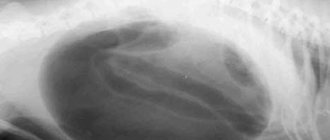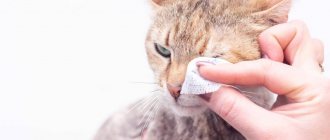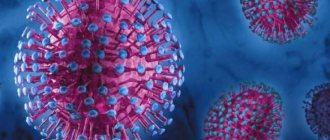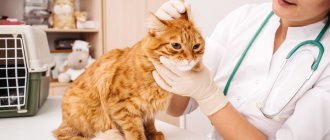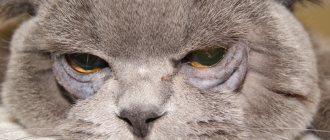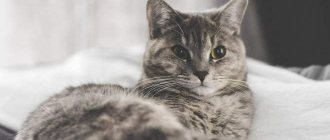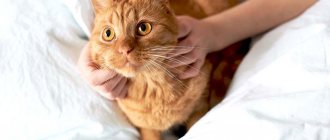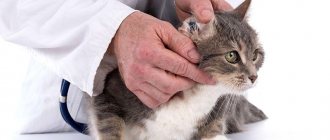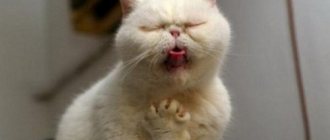Animals, like people, are not immune from serious illnesses. There are ailments, the positive outcome of which depends on how quickly the cat or dog is taken to the veterinary clinic. The most important thing is not to waste precious time. Volvulus in cats is one such disease. Large dogs weighing more than 25 kg are more susceptible to it. Cats get sick much less often. But this does not mean that there is no danger of getting sick for them.
What is the disease
Intestinal volvulus is the twisting of the intestinal loop around the mesenteric axis or the rotation of one of its sections relative to another. It entails the closure of the intestinal lumen. Large arteries are compressed, resulting in disruption of nutrition and blood supply to the intestinal wall. Intestinal obstruction forms, the bloodless tissues gradually necrotize (die). If urgent measures are not taken, the pathological process will be complicated by sepsis and peritonitis. It will be impossible to save the animal.
In cats, the disease has three development options:
- volvulus of the small intestine (a significant part of the intestine located between the stomach and large intestine);
- volvulus of the colon and cecum;
- eversion of part of one intestine into the lumen of another (intussusception).
What causes volvulus?
Veterinarians name many factors that cause the development of this phenomenon. This is about:
- Poor nutrition;
- The occurrence of tumors, the appearance of a hernia, as well as the development of other painful processes in the gastrointestinal tract;
- Frequent constipation, which is highly likely to cause volvulus;
- Foreign bodies that may end up first in the animal’s stomach and then in its intestines;
- Excessive mobility of the cat after the next meal.
To minimize the risk of intestinal problems, it is necessary to take care of the animal's proper nutrition. Once a week, liquid food, for example, broth or soup, should be introduced into the cat's diet. The animal's diet should not be the same as its owner's diet. But due to a lack of liquid food, the likelihood of coprostasis (frequent constipation) will increase sharply. A cat can also develop ileus (intestinal obstruction).
Foreign bodies in the intestines (for example, threads and even your own hair) can also trigger constipation. From the stomach they will soon move to the intestines, where they will inevitably become tangled. As a result, the animal begins to suffer from constipation, obstruction, and also from entanglement of the intestines. At such moments, you should categorically refuse to use laxatives. Taking them will only complicate the situation and will most likely provoke intestinal rupture.
In kittens and puppies, due to their increased activity, volvulus develops especially often. Due to continuous running and frequent jumping, cramps periodically occur in the intestines. There may be other causes of volvulus, but these are the ones veterinarians encounter most often.
Causes of the disease
Experts believe that the main causes of the disease are congenital anomalies in the development of the intestine, mesentery (the ligament with which the hollow organs of the abdominal cavity are fixed to its wall) and the adhesive process in the intestine.
The onset of the pathological process can be provoked by several factors. They are, as it were, secondary causes of the disease:
- a sharp change in intra-abdominal pressure that occurs during significant physical activity (running, outdoor games) on a full stomach;
- improper diet, in which prolonged hunger is replaced by heavy feedings, sharply increasing intestinal motility;
- entry of a foreign body into the kitten’s intestines due to accidental ingestion;
- use of low quality feed;
- long-term bowel dysfunction (constipation);
- tumor diseases of the gastrointestinal tract.
The risk group usually includes kittens that are not yet one year old. But even an adult animal can develop intestinal pathology if one or more risk factors are present.
Symptoms
The blockage may occur in the stomach or intestines. Obstruction of the gastric outflow leads to the accumulation of ingested solids and liquids in the stomach.
This can lead to vomiting, subsequent fluid loss, including gastric secretions rich in hydrochloric acid, and possible dehydration, lethargy and weight loss, depending on the severity of the condition.
Small intestinal obstruction causes ingested solids and liquids to accumulate in the intestine in the area of the obstruction. Subsequent vomiting can lead to significant dehydration and electrolyte imbalance, depending on the exact location of the blockage in the intestines.
Damage to the protective lining of the intestines and intestinal ischemia (in which the blood supply to the intestines is limited) can also potentially lead to the presence of toxins in the blood.
The main symptoms that may appear include vomiting, especially after eating, anorexia, weakness, diarrhea and weight loss.
Symptoms
Volvulus in a cat has a variety of symptoms, which are especially pronounced if the small intestine is involved in the process. The animal begins to suffer from acute cramping pain. It cannot tell the owner about them, but makes it clear that it is uncomfortable. It worries, pays attention to the stomach, tries to lie down and curl up into a ball. Intestinal peristalsis, which increased at the onset of the disease, is replaced by a sharp weakening (paresis). As the disease progresses, other symptoms appear:
- bloating and asymmetry of various parts of the abdomen;
- increasing vomiting of eaten food;
- dehydration of the body, “drying out” of the body;
- a significant increase in general temperature;
- lack of stool for several days;
- increasing weakness, pallor of the mucous membranes;
- shock and loss of consciousness.
Volvulus of any part of the large intestine is less common and is characterized by more mild symptoms. But in any case, if the patient is not provided with medical assistance in a timely manner, the outcome of the disease will be unfavorable.
Symptoms of intestinal obstruction in cats
With partial obstruction, only part of the intestinal contents penetrates through the obstruction, and with complete obstruction, the movement of feed masses stops. Therefore, one of the symptoms is a small amount of feces or their complete absence. In both cases, in the area of the intestine where the blockage occurred, blood circulation is disrupted, which can lead to necrosis, that is, death of part of the intestine. Complete obstruction is characterized by severe clinical manifestations such as sudden onset of vomiting, depression, anorexia, abdominal pain and collapse. This condition is life-threatening for the animal and urgent surgical intervention is required.
The general condition of the cat depends on the degree of obstruction (low, medium, high), the size of the foreign body and the duration of the disease.
The following are the main symptoms of intestinal obstruction in cats:
- decreased appetite, sometimes reaching the point of complete refusal of food;
- periodic vomiting that occurs in most cases;
- reduction in the amount of feces or their complete absence;
- pain and increased abdominal volume;
- deterioration of general condition.
Dehydration of the body is also noted as a result of impaired water absorption and an imbalance of intestinal microflora. With prolonged fasting, exhaustion may occur, and as a result, the overall body temperature decreases (less than 37? C), general weakness occurs, and shortness of breath may occur. If help is not provided to a cat in this condition, this may result in the death of the animal.
Therefore, if the above clinical signs occur, you should immediately contact a qualified veterinarian at a veterinary clinic.
It should also be understood that each case is individual, and not all cats have pronounced symptoms. In some animals, intestinal obstruction may manifest itself with only a few of the signs listed above, so you should be attentive to your pets and pay special attention to even subtle changes in their condition.
Diagnostics
Only a veterinarian can diagnose volvulus. After conducting a clinical examination of the animal, he can already make a preliminary diagnosis. Plain radiography, the main and most accurate method for diagnosing this disease, will help clarify it. The x-ray clearly shows pathological changes, areas of enlarged intestinal loops, supplemented by a clear sign - intestinal obstruction. Auxiliary diagnostic methods will help clarify the picture of the disease:
- Ultrasound of the abdominal cavity;
- bacteriological analysis of vomit;
- laboratory blood test.
The purpose of these diagnostic measures is to differentiate the original disease from other conditions similar to it:
- tumor and inflammatory diseases of the gastrointestinal tract;
- adhesive disease;
- renal colic.
First Aid Procedures
At the first signs of the disease, you should turn to those measures that, although they will not solve the problem completely, will reduce the cat’s suffering:
- The animal will need a painkiller injection. Painful sensations will decrease, and the likelihood of a painful shock in the cat will significantly decrease. But you shouldn’t give him pills (orally);
- Since the animal will vomit quite often, it is better to lay it on a rag and not disturb it unnecessarily;
- It is forbidden to feed the cat, otherwise its condition will certainly worsen due to intestinal obstruction;
- The cat needs to drink, so you need to put water next to it;
- An animal suffering from volvulus should be immediately taken to a veterinarian for examination. The sooner he can begin treatment (surgery), the sooner the cat will recover.
Treatment and rehabilitation
The disease is treated exclusively surgically - laparotomy. Preparation for surgery should be urgent, since the cat’s condition can rapidly deteriorate. The count of time when an animal can be saved is counted in minutes.
The operation includes the following tasks:
- straightening of torsion of intestinal loops;
- viewing sections of the intestine and segmental resection of that part in which necrotic changes began;
- An ileostomy (extraction of the small intestine onto the anterior abdominal wall for the outflow of pus and inflammatory exudate) is necessary in the presence of peritonitis.
Even if medical care is provided in a timely manner, the outcome of the disease can lead to disability of the animal. After resection of part of the intestine, its functions may be impaired. Therefore, the operated animal will require constant attention and proper care from the owner.
After the operation, it is recommended to leave the cat in the clinic for several days for medical observation. Rehabilitation therapy lasts several months and takes place on an outpatient basis. Restorative treatment should provide comprehensive support to the body:
- antibiotic therapy is aimed at avoiding severe inflammatory complications of the postoperative wound;
- taking painkillers will help relieve severe pain (Baralgin);
- the administration of probiotics is intended to restore damaged intestinal microflora (“Essentiale”);
- infusion of saline solutions is necessary to restore water-salt balance and rehydrate (treat dehydration) of the body;
- a gentle diet is needed to protect the gastrointestinal tract from unnecessary stress.
A very important condition for successful recovery after surgery is compliance with the rules of asepsis and antisepsis when caring for the animal. The addition of any infection during this period can be fatal for him.
What to do if you suspect intestinal obstruction in a cat
If you notice symptoms of intestinal obstruction in your pet or suspect that the cat may have swallowed any foreign objects, immediately seek help from a veterinary clinic!
Do not force feed or water your cat, as this may cause vomiting. You should not give antiemetic drugs that do not have a therapeutic effect. Laxatives and drugs that enhance intestinal motility may in some cases be contraindicated, since their action can lead to intestinal rupture.
Clinical signs may not always be clear, so you need to contact a qualified specialist at the clinic as soon as possible, since the clinic has all the necessary equipment for a speedy diagnosis.
Prevention
Good prevention of all diseases of the gastrointestinal tract of domestic animals is the careful implementation of the conditions for keeping them:
- feed the cat several times a day in small portions;
- immediately after feeding, do not allow your pet to run and frolic for a while;
- use only high-quality, easily digestible feed for feeding;
- ensure that the animal always has free access to clean water;
- protect your pet from unnecessary worries, stress and negative emotions;
- carry out timely treatment of inflammatory diseases of the stomach and intestines.
Volvulus is a serious illness that is difficult to treat. It is much easier to prevent it from starting than to later take emergency and painful measures to save the animal.
Which breeds are more susceptible
Ileus can occur in any cat, regardless of age or gender. Representatives of long-haired breeds, for example, Persians, Siberians, Maine Coons, are most susceptible to this phenomenon. Numerous hair that enters the stomach during licking forms trichobezoars - dense hairballs. They are the most common cause of intestinal obstruction.
What danger does the disease pose?
Ignoring or untimely provision of medical care is fraught with the appearance of complicated conditions:
- general poisoning (intoxication) of the victim’s body;
- development of a state of dehydration;
- the appearance of peritonitis - a dangerous inflammation of the peritoneum;
- gangrene develops in the affected area of the intestine;
- perforation of the intestine.
Caring for a sick cat
After initial treatment, symptoms and progress should be monitored. It is important to replace fluid loss (for example, due to excessive vomiting or diarrhea) to avoid dehydration.
Physical activity should be limited and the diet should consist of bland foods for one to two days, followed by a gradual return to normal eating. Please note that it should not be given orally until the obstruction has been removed and vomiting has stopped.
Diet
First, after surgery, complete fasting is established for 24 hours, with intravenous glucose. Sometimes, with extensive intestinal removal, parenteral feeding is required for several days.
The cat is then placed on a nasogastric tube or latex tube, which feeds food directly into the stomach.
Afterwards, liquid food should be introduced - vegetable purees and cereals with water, then meat purees and dairy products are gradually introduced. Then you can switch to soft food; in the first months after surgery, the cat can be fed baby food.
Feed should be fractional, in small portions, gradually increasing the amount of food per day to the normal weight.
The main problem after surgery is “short” bowel syndrome; the absorption surface decreases, which causes diarrhea and malabsorption syndrome.
Drug therapy
Infusion therapy must be prescribed to relieve the state of shock and normalize the water-salt balance. Usually saline solutions, Ringer-Locke solution, etc. are used.
A course of antibiotics is used to prevent postoperative complications and prevent the development of an infectious process. It is also necessary to prescribe prednisone, it provides relief from shock and prevents the development of adhesions.
For pain relief use baralgin or dalargin.
Enzyme support should be prescribed - Essentiale, Panzinorm.
Intramuscular administration of vitamin B12 is used as rehabilitation.
